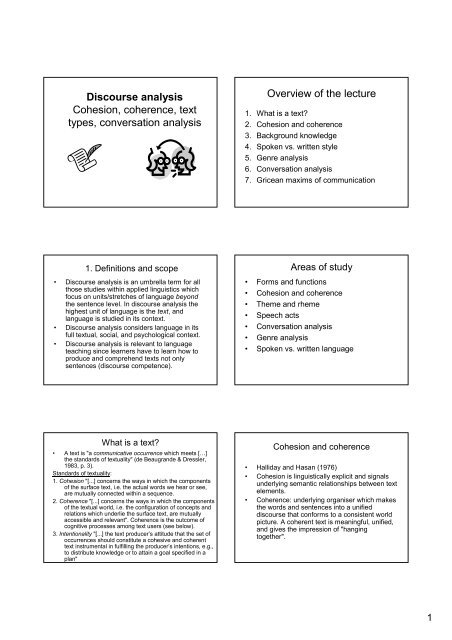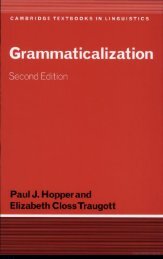Create successful ePaper yourself
Turn your PDF publications into a flip-book with our unique Google optimized e-Paper software.
Discourse analysis<br />
Cohesion, coherence, text<br />
types, conversation analysis<br />
1. Definitions and scope<br />
• Discourse analysis is an umbrella term for all<br />
those studies within applied linguistics which<br />
focus on units/stretches of language beyond<br />
the sentence level. In discourse analysis the<br />
highest unit of language is the text, and<br />
language is studied in its context.<br />
• Discourse analysis considers language in its<br />
full textual, social, and psychological context.<br />
• Discourse analysis is relevant to language<br />
teaching since learners have to learn how to<br />
produce and comprehend texts not only<br />
sentences (discourse competence).<br />
What is a text?<br />
• A text is "a communicative occurrence which meets […]<br />
the standards of textuality" (de Beaugrande & Dressler,<br />
1983, p. 3).<br />
Standards of textuality:<br />
1. Cohesion "[...] concerns the ways in which the components<br />
of the surface text, i.e. the actual words we hear or see,<br />
are mutually connected within a sequence.<br />
2. Coherence "[...] concerns the ways in which the components<br />
of the textual world, i.e. the configuration of concepts and<br />
relations which underlie the surface text, are mutually<br />
accessible and relevant". Coherence is the outcome of<br />
cognitive processes among text users (see below).<br />
3. Intentionality "[...] the text producer’s attitude that the set of<br />
occurrences should constitute a cohesive and coherent<br />
text instrumental in fulfilling the producer’s intentions, e.g.,<br />
to distribute knowledge or to attain a goal specified in a<br />
plan"<br />
Overview of the lecture<br />
1. What is a text?<br />
2. Cohesion and coherence<br />
3. Background knowledge<br />
4. Spoken vs. written style<br />
5. Genre analysis<br />
6. Conversation analysis<br />
7. Gricean maxims of communication<br />
Areas of study<br />
• Forms and functions<br />
• Cohesion and coherence<br />
• Theme and rheme<br />
• Speech acts<br />
• Conversation analysis<br />
• Genre analysis<br />
• Spoken vs. written language<br />
Cohesion and coherence<br />
• Halliday and Hasan (1976)<br />
• Cohesion is linguistically explicit and signals<br />
underlying semantic relationships between text<br />
elements.<br />
• Coherence: underlying organiser which makes<br />
the words and sentences into a unified<br />
discourse that conforms to a consistent world<br />
picture. A coherent text is meaningful, unified,<br />
and gives the impression of "hanging<br />
together".<br />
1
Categories of discourse cohesion<br />
Grammatical<br />
Lexicogrammatical<br />
Lexical<br />
Reference<br />
Arthur's very proud of his Chihuahuas. I don't<br />
like them.<br />
Substitution<br />
Tell a story. – I don't know one.<br />
Ellipsis<br />
How did you enjoy the paintings? – A lot (of the<br />
paintings) were very good but not all (the<br />
paintings).<br />
Conjunction<br />
They thought he didn't believe them. And this<br />
was true.<br />
Lexical cohesion<br />
He met an old lady. The lady was looking at<br />
him for a while...<br />
Relationship between cohesion and<br />
coherence<br />
• Cohesion and coherence are related notions, but they<br />
are clearly distinct. There are two types of views<br />
concerning their relationship.<br />
A) Cohesion is neither necessary nor sufficient to account<br />
for coherence.<br />
A: That's the telephone.<br />
B: I'm in the bath.<br />
A: O.K.<br />
(Widdowson, 1978, p. 12)<br />
B) Cohesion is necessary, though not sufficient in the<br />
creation of coherent texts. In other words, cohesion is<br />
a crucial though not exclusive factor contributing to<br />
coherence, since it facilitates the comprehension of<br />
underlying semantic relations.<br />
Some areas of investigation<br />
• How does cohesion contribute to coherence in native<br />
speech/writing?<br />
• How does cohesion contribute to coherence in non-native<br />
speech/writing?<br />
• Comparison of cohesion in native and non-native<br />
speech/writing;<br />
• Comparing cohesion in different genres (newspaper<br />
articles, novels, informal letters, informal dialogues, etc.);<br />
• Cohesion in child language and adult language;<br />
• Cohesion at the different levels of language proficiency;<br />
• Cohesion in different languages;<br />
• Cohesion in disordered vs. normal talk;<br />
• Cohesion in translations;<br />
• Teaching cohesion to non-native speakers.<br />
Reference<br />
• Anaphoric reference: referring<br />
backwards E.g. I can see a bird. It is<br />
singing. (It refers backwards to bird.)<br />
• Cataphoric reference: referring forward.<br />
E.g. When they arrived at the house, all<br />
the participants were very tired. (They<br />
refers forward to participants).<br />
Background knowledge (schemata)<br />
• Frames: data structures that represent stereotypical<br />
situations.<br />
• Scripts: contain information on event sequences.<br />
Scripts may include scenes, roles and props.<br />
• Scripts help explain that expectations play an<br />
important role in understanding discourse. When we<br />
hear a situation being described, we expect that<br />
certain events take place.<br />
• Schema/schemata: high-level complex knowledge<br />
structures (van Dijk, 1977) that help the organisation<br />
and interpretation of one's experience. "Schemata lead<br />
us to expect or predict aspects in our interpretation of<br />
discourse" (Brown & Yule, 1983, p. 248). Schemata<br />
help explain why a text is understood easier and faster<br />
if a title is provided.<br />
• Schemata can also be culture-specific; for example the<br />
schema of a wedding ceremony varies culture by<br />
culture.<br />
Text types: Comparing written and<br />
spoken texts<br />
1. Written language<br />
Functions of written language:<br />
• action: e.g. public signs, product labels and instructions,<br />
recipes, maps, TV-guides, bills, menus, telephone<br />
directories.;<br />
• social contact: e.g. letters, postcards, greeting cards;<br />
• information: e.g. newspapers, magazines, non-fiction<br />
books, textbooks, advertisements, reports, guidebooks;<br />
• entertainment: e.g. light magazines, fiction books,<br />
poetry, drama, film subtitles, games.<br />
2
Spoken language<br />
• Intonation expresses grammatical, attitudinal, and<br />
discourse meaning.<br />
• Tone (melody): fall, rise-fall, rise, fall-rise, level<br />
• Prominence<br />
• It was INteresting.<br />
• It WAS interesting.<br />
• Functions of spoken language:<br />
• action: guidelines or directions given, teacher<br />
instructions;<br />
• social contact: telephone conversations, chats;<br />
• information: lecture, presentation, political speech;<br />
• entertainment: jokes, radio programs<br />
Genre analysis<br />
All text-types have their own system of linguistic, rhetorical<br />
and organisational characteristics. Therefore, genre<br />
analysts set out to investigate what makes a letter a<br />
letter, or what makes a radio announcement a radio<br />
announcement.<br />
"A genre comprises a class of communicative events the<br />
members of which share some set of communicative<br />
purposes. These purposes are recognized by the expert<br />
members of the parent discourse community, and<br />
thereby constitute the rationale for the genre. This<br />
rationale shapes the schematic structure of the<br />
discourse and influences and constrains choice of<br />
content and style. … Exemplars of a genre exhibit<br />
various patterns of similarity in terms of structure, style,<br />
content and intended audience. If all high probability<br />
expectations are realized, the exemplar will be viewed as<br />
prototypical by the parent discourse community"<br />
(Swales, 1990, p. 58).<br />
Conversation analysis<br />
Conversation has been considered as the most<br />
fundamental means of conducting human affairs since<br />
this is the prototypical kind of language usage.<br />
Purposes of conversation:<br />
• Exchange of information<br />
• Creating and maintaining social relationships (e.g.<br />
friendships)<br />
• Negotiation of status and social roles<br />
• Deciding on and carrying out joint actions (co-operation)<br />
The primary and overriding function of conversation is<br />
clearly the social function, i.e. the maintenance of social<br />
relationships.<br />
Spoken language<br />
Shared situation<br />
On-line interaction<br />
(two-way)<br />
Verbal and non-verbal<br />
means<br />
No careful editing<br />
Time pressure<br />
Written language<br />
No shared situation<br />
Delayed interaction<br />
(one-way)<br />
Verbal means<br />
Revising, editing<br />
possible<br />
No time pressure<br />
Linguistic analyses of various genres<br />
Linguistic phenomenon<br />
lexical density: ratio of<br />
grammatical (function) words<br />
and lexical (content) words<br />
nominalization: number of<br />
nouns<br />
type/token ratio: number of<br />
newly introduced lexical<br />
items<br />
repetition: number of<br />
repeated lexical items<br />
personal pronouns (1st and<br />
2nd person)<br />
Frequency<br />
Formal (informational<br />
genres) informal genres<br />
Formal (informational<br />
genres) informal genres<br />
Formal (informational<br />
genres) informal genres<br />
Formal (informational<br />
genres) informal genres<br />
Formal (informational<br />
genres) informal genres<br />
Conversational rules and structure<br />
• Openings: There are conventional routines for openings.<br />
E.g.: greetings, introduction, opening questions.<br />
• Closings: Intentions to close a conversation are usually<br />
expressed with closing signals such as 'well', 'so', 'okay'<br />
used with falling intonation.<br />
• Turn-taking mechanisms: intention to let the<br />
conversational partner speak is signalled with low voice,<br />
slowing down, putting a question, body movement. In<br />
smooth communication less than five per cent is<br />
delivered in overlap.<br />
• Adjacency pairs: utterances which require an immediate<br />
response or reaction from the partner (greeting-greeting,<br />
offer-accept, compliment-thank, question-answer); there<br />
are always preferred and non-preferred answers, and it<br />
is difficult for learners to distinguish between them<br />
• Back-channelling: signals that show the speaker that<br />
his/her message is understood and listened to.<br />
Examples: Uhhuh, yeah, right.<br />
3
Gricean maxims of communication<br />
Grice (1975) proposed four criteria for co-operative<br />
communication:<br />
A) Maxim of relevance: In communication, each person's<br />
contribution has to be relevant to the topic. For<br />
example in the following exchange this maxim is not<br />
observed:<br />
A: Would you like some coffee?<br />
B: I disagree with this solution.<br />
B) Maxim of truthfulness: Contributions in conversations<br />
should be truthful (exceptions are jokes, deliberate<br />
lies).<br />
c) Maxim of quantity: In conversations, talking time should<br />
be fairly divided between interlocutors, and one should<br />
strive for brevity (this maxim is often not observed).<br />
D) Maxim of clarity: Messages conveyed should not be<br />
obscure or ambiguous.<br />
Overview<br />
• What is cohesion and what is coherence?<br />
• What is the relationship between cohesion and<br />
coherence?<br />
• What are the categories of discourse cohesion in<br />
English? Illustrate each category with an example.<br />
• How do frames, scripts and schemata help understand<br />
discourse?What are the differences between spoken<br />
and written language?<br />
• List examples for the functions of spoken and written<br />
language.<br />
• List some aspects of comparison in genre analysis.<br />
• How do formal genres differ from informal genres?<br />
• List the four main purposes of conversation.<br />
• What characterises conversations?<br />
• List some elements of conversation and give an<br />
example for each.<br />
• List and explain Grice's (1975) four maxims.<br />
Non-observance of maxims<br />
Flouting a maxim: the speaker blatantly fails to observe<br />
the maxim, because he wants to the hearer to find<br />
additional meaning to the one expressed. This is called<br />
conversational implicature. For example:<br />
• How are you getting there?<br />
• We are getting there by car (meaning you are not<br />
coming with us – maxim of quantity flouted because it<br />
would have been enough to say by car).<br />
Violating a maxim – speaker wants to mislead the listener<br />
intentionally.<br />
Infringing a maxim – not observing the maxim because of<br />
lack of linguistic knowledge (e.g. L2 learners).<br />
Opting out of a maxim – the speaker is unwilling to abide<br />
by the maxims (e.g. withholding information).<br />
Suspending a maxim – in certain situations it is not<br />
necessary to observe the maxims (e.g. poetry).<br />
4
















